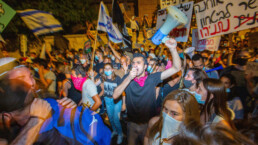Activists tell +972 that they want to challenge Israeli protesters to look beyond the far-right coalition and see the conditions that enabled its rise.
by Ben Reiff, +972 Magazine
Amid a sea of Israeli flags in downtown Tel Aviv last Saturday, carried by the more than 100,000 protesters attending the biggest anti-government demonstration in recent history, stood a pocket of protesters that looked rather out of place. For those marching past them all evening, they were impossible to miss — and that was the point.
Palestinian flags were waved aloft, while striking black banners were unfurled, bearing slogans such as “There’s no democracy with apartheid,” and “A nation that occupies another nation will never be free.” They chanted in support of the Israeli teenagers currently serving jail time for refusing to enlist in the army, and handed out flyers that concluded: “Instead of mourning a pseudo-democracy, let’s demand change from the root!”

An amalgam of dozens of independent activists, several established anti-occupation groups, and a contingent from the left-wing Hadash party, the “radical bloc” has grown larger and more prominent with each demonstration over the past three weekends, growing to a few hundred people on Jan. 21. And while their numbers may be dwarfed by the wider protest, their Palestinian flags and signs calling for decolonization have drawn the ire of both the main demonstration and the people they are protesting against — escalating to confrontations and physical attacks in every protest so far.
Recent Posts
‘Unconstitutional. Unethical. Authoritarian.’ ICE Bars Millions Of Immigrants From Bond Hearings
July 18, 2025
Take Action Now One watchdog said the new policy “seems like a blatant attempt to stop them from exercising their right to due process.”……
Americans Are Not Nearly Alarmed Enough About Climate Change
July 18, 2025
Take Action Now Americans still don’t comprehend how imminent, dangerous, and far-reaching the threat is—and journalists are partly to blame.By…
The IRS Is Building A Vast System To Share Millions Of Taxpayers’ Data With ICE
July 17, 2025
Take Action Now ProPublica has obtained the blueprint for the Trump administration’s unprecedented plan to turn over IRS records to Homeland Security…
Israel’s Sudden Assault On Syria Is Unchecked Aggression
July 17, 2025
Take Action Now Jerusalem is bombing Damascus and threatening al-Sharaa’s rule, while Washington was hoping to help the nascent government on…




